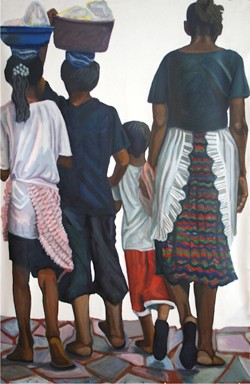
- "Agobio"
Can paintings qualify as portraits when they don’t depict a subject’s face? They can, and do, in Chepe Cuadra’s show at Bristol’s WalkOver Gallery titled “Back Portraits/In Search of an Identity.”
In a dozen or so large-format oils, the Nicaraguan Vermonter manages to convey something about the personalities, emotions and life circumstances of individuals seen only from behind. A few of these paintings achieve a degree of poignancy that Cuadra might not have attained working in traditional portraiture.
An artist’s intentions and interpretation can be easy to read when facial features are in full view; Cuadra’s back portraits ask that viewers play a more active role. We’re made to focus closely on the subtle signals sent by the body language of these faceless figures. It’s the difference between the insinuation of a striptease and the bluntness of a nudist camp.
“Agobio,” for example, probably would not be any more moving if its four figures faced front. The stooped shoulders of the plodding woman on the right may express her exhaustion more effectively than could droopy eyelids and a furrowed forehead. The three children walking closely alongside her have the erect posture of youth. But the two adolescents — presumably a sister and brother — balance heavy loads on their heads, while a small boy in sagging red shorts keeps the slow pace of what must be a family heading home after a long day’s work.
Warmth and tenderness also suffuse “Good Morning,” an equally simple and evocative painting of parenthood. Here, a man pedals a bicycle as he supports a young child on his left knee. A pink sack emblazoned with flowers, a heart and a Hello Kitty image is slung over the cyclist’s shoulder. Cuadra doesn’t need to reveal the faces of this dad and daughter to convey their loving, trusting relationship.
The artist also displays his technical skill in the persuasive perspective of the two-wheeler and the shadow it casts on the street. Cuadra’s 40 years of experience with brush and canvas are evident throughout a show that meets high formalist standards, even though these paintings vary little in theme and method.
Most of the pieces suggest the dignity and physical toll of manual labor. Everyone depicted in this suite of paintings has black or brown skin and is shown in motion outdoors, often in what appears to be a market setting. Cuadra, who was born in California but grew up in Nicaragua, displays a familiarity, approaching intimacy, with the daily lives of the toiling people he paints. He’s a Millet of the tropics.
“Marchanta” — 9 feet high and 5 feet wide — is epic in scale, lending grandiosity to the everyday tableau of a woman in pedal pushers toting a big basket as a girl bearing a basin on her head chugs alongside. A man lists to the left in “Yucca Load,” straining under the weight of his burden. “Plantanos,” which is almost as large as “Marchanta,” consists solely of a shirtless man in an orange do-rag bowed beneath bunches of green bananas piled in an enormous basket atop his head.
Cuadra, who lives in St. Albans and teaches art at Johnson State College, notes in an artist’s statement that his back portraits enable him to “connect with a lost or forgotten part of my history, my family history, my friends’ history … my inner self.” Intriguingly, he also equates backs with “the past of time.”
Some visitors to the WalkOver show might assume that Cuadra paints only backs because he’s not adept at painting faces. A look at his website dispels that suspicion. Samples there show him to be a versatile artist who sculpts in clay and metal as well as composing big oil studies of fruit and, yes, a series of facial portraits, including the crinkled mug of Rolling Stones guitarist Keith Richards.
“I love the exoticism and sensuality of fruits,” Cuadra writes on his website. “I feel their shapes are provocative and inspiring.”
There isn’t much sensuality or provocative posing in “Back Portraits,” however. Almost all of Cuadra’s subjects are shown fully clothed. One partial and notable exception is “El Café,” in which an orange bra strap protrudes from the green tank top of a woman carrying coffee canisters. Cuadra’s paintings hence cannot be associated with the current trend, identified in a recent New York Times article, of picturing women’s bare backs on book covers. “Sex sells,” the Times writer unnecessarily notes.
“Back Portraits” does lapse into coy gimmickry in a couple of pieces. So intent is Cuadra on not allowing a face to appear in this show that he twice deploys a subject’s raised arm to blot out the features of a background figure who is looking toward the viewer. In this way, the artist maintains the conceit of allowing viewers to see his subjects without, in turn, being seen.
Chepe Cuadra, “Back Portraits/In Search of an Identity,” WalkOver Gallery, Bristol. Through October 25. Info, 453-3188. chepecuadra.com. Artist talk and reception, September 27, 6 p.m.
The original print version of this article was headlined "Rear Views"




Comments
Comments are closed.
From 2014-2020, Seven Days allowed readers to comment on all stories posted on our website. While we've appreciated the suggestions and insights, right now Seven Days is prioritizing our core mission — producing high-quality, responsible local journalism — over moderating online debates between readers.
To criticize, correct or praise our reporting, please send us a letter to the editor or send us a tip. We’ll check it out and report the results.
Online comments may return when we have better tech tools for managing them. Thanks for reading.